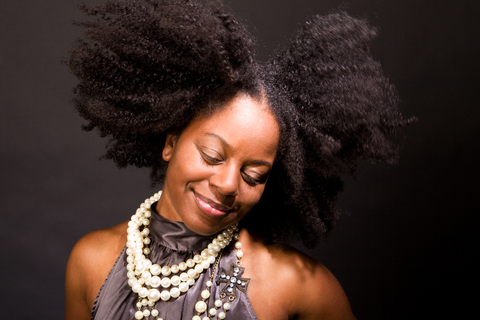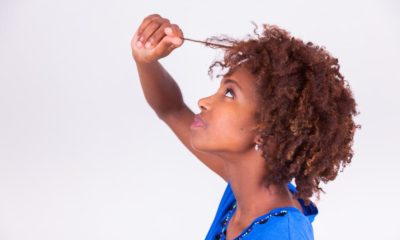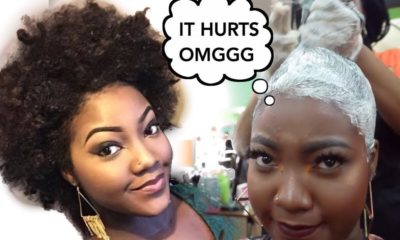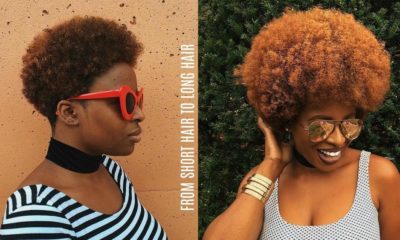Features
Nicole Ezeh: Dear Naturalista, the Natural Hair Journey is Not Expensive
 Nicole: Hey Teniola, your outfit looks amazing. How have you been?
Nicole: Hey Teniola, your outfit looks amazing. How have you been?
Teniola: Oh, this old dress? I’ve been managing, my dear. Your hair looks breathtaking. You people and this your natural hair sef. I always love seeing your hair but it’s sha too expensive to maintain.
Nicole (while gazing intently at her 350k weave): No, it’s not. It’s a matter of choice. You decide whether you want to break the bank or not in this journey and you don’t need…
Teniola: Ehn, warefa. I don’t have the time or energy
Nicole: But…..
Are you a naturalista, who’s had this or a similar scenario played out in front of you so much, you can’t recall how many times it has? You’re not alone. Teniola actually has a valid reason. Nicole may have been the only natural whom she’s met that is not a product junkie, so Teniola is not making unfounded statements. I reiterate that the natural hair journey is not an expensive one. Why do you have so much unnecessary products all over your shelf? I guess the real question is: why do you feel you need so many products to enjoy healthy hair strands? After much unconscious research, I’ve found that the ones with the most luxurious hair hardly cleanse, steam or have up to five products. The basic things that ensure you enjoy your journey and have awesome results will be highlighted in this article:
Hot Oil Treatments/Prepoo
This is a step in your regimen that can be achieved with just a natural oil. Pre-mixed hot oil treatments/prepoos are not necessary as unsavory ingredients (which are not natural but chemicals) are contained therein. That is not the problem with it, since I’ve stopped being an ingredient Nazi. The problem is the cost of the 16-ounce tub of 70% hype and 30% effectiveness. Coconut oil, Olive oil, Castor oil, Grapeseed oil, each used alone can give you better results. The different oils you own can be mixed and the mixture applied as your hot oil treatment. A 100g of herbs can be infused with a litre of coconut oil and you’re set for the year. Palm kernel oil mixed with a fragrance essential oil is enough.
Clarifying
There is an immeasurable amount of shampoos everywhere, but I bet the good ol’ African black soap never crossed your mind. It didn’t cross mine either at first, but when it did, branded shampoos were indefinitely suspended. Bentonite clay can be used also to clarify and guess what? It is a cleanser, deep conditioner and curl definer all in one.
Another option for clarifying is Castile soap. Get a bar of dudu osun, cut it into tiny little pieces and pour in 2 litres of boiling water. Allow to stand for some hours, stir and dispense into old shampoo bottles. 2 litres of shampoo is enough for a year. An ounce of Castile soap topped with three ounces of water is sufficient for each clarifying session. Clarifying can be done twice a month.
Cowashing
This is where it gets a little bit complicated if you are an ingredient Nazi. I think I can authoritatively declare that every conditioner is made up of strictly chemicals. If you are avoiding silicones, VO5 and Suave naturals are insanely cheap conditioners which do not contain silicones. Cowashing is washing with a conditioner only. This can be done, depending on your schedule, twice a month in between clarifying.
After-wash Rinse
These can be used to prevent or combat excessive shedding. If you detangle your hair carefully or so much as run your hands through your hair (*coughs, assuming you can) and notice your hair strands falling off, you need an after-wash rinse. Tea rinses and coffee rinses are ideal for excessive shedding. This is because the caffeine contained in the tea and coffee strengthen the hair strands at the root causing the weak link between the hair and scalp to become stronger. This naturally implies that decaffeinated coffees are not to be utilized. Black, green and red teas can be used. To get the most out of a tea bag, it is advisable to boil the teabags with the water as opposed to steeping it in boiling hot water. Pour it over your hair, massage it in and leave for 20 minutes. You may wash it off or not – though it tends to leave the hair hard and dry in some cases. In a year, you only get to use four packs of tea, saving you so much cost rather than buying a branded product which may just be a waste of resources.
Deep Conditioning
There are deep conditioners which seem to be made solely for you, but they contain Petrolatum and other not-so-great ingredients but my new motto in Naija speak is, ‘Me I cannot come and kee (kill) myself’. Youtubers like JourneyToWaistLength swear by cheap deep conditioners like Mega Profectiv deep conditioner. Once, I also read a very guilt-ridden post by Ekene of Kink and I where she steamed her hair with Africa’s Best Hair Mayonnaise and it turned her hair really soft, but the downside was (and still is) that the ingredient list made you cry.
I really do not care about those things anymore; though regular usage is not advised, it’s not a crime for a girl to want a deep conditioning treatment that leaves her hair soft with her pocket happy. If it is, sue me already. Do-it-yourself deep conditioners are cost-effective and completely safe. Luckily, I tend to stick more to DIYs than the above mentioned deep conditioners. Here is an article listing twenty do-it-yourself deep conditioner recipes which can save you a wad of cash.
Moisturizing
The LOC method is the standard procedure for moisturizing natural hair. Depending on your hair’s preference, LCO method can be used. This stage is broken down into three sub-stages:
Liquid
This is the first step in the LOC method. This process can be achieved with warm water or a leave-in conditioner. A DIY leave-in conditioner mix can be easily prepared with a conditioner and a few oils whipped to mix well.
Oil
This can be any single natural oil or oil mix. If you can, prepare your coconut oil at home. It involves shelling the coconuts, grating/blending, pressing the coconut milk out after adding some water, leaving the coconut milk overnight in an airtight container, separating the puree from the water with a spatula the next morning and boiling the puree to extract the oil.
Cream
Depending on your location, avocado, shea, mango or cocoa butters mixed with an oil or two can be whipped into a light, fluffy cream and preserved in a tub.
Stylers
For styling, you may still use whipped butters if you want big, fluffy hair. Some cheap alternatives include: setting lotions, eco styler gels (any styling gel will do), foam wrap lotions/mousse.
Supplements
Water and fruits are the only supplements you need. Vitamins, Proteins and Minerals are contained therein. Increase your water and fruit intake and your hair will flourish
These are the basic steps in a standard natural hair regimen. You can skip any step you want as some do by just cleansing and moisturizing once in a while. It’s okay. Don’t nobody gat time for all that stress. If you are the meticulous type, you can add the prices up and see that you get to spend less than #30,000 per annum.
Sorry for the six-month hiatus. Life happened. I’m back. I’ll see you in my next article. Peace and blessings. God bless you.
Photo Credit: Noriko Cooper | Dreamstime.com

























